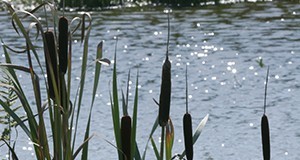Abstract
Man-made ponds can be a useful way to collect, store, and treat stormwater runoff in residential areas. However, these ponds can become polluted when runoff contains fertilizers, pesticides, and pet waste from the neighborhood. This 9-page fact sheet outlines several best management practices (BMPs) for reducing stormwater pond pollution. Based on a survey of residents who live near stormwater ponds, the authors recommend strategies Extension educators can use to encourage residents to adopt these BMPs. Written by Emily Ott, Paul Monaghan, Ondine Wells, Gail Hansen, Laura Warner, and Michelle Atkinson, and published by the UF Department of Agricultural Education and Communication, July 2015.
References
Brehm, J. M., Pasko, D. K., Eisenhauer, B.W. (2013). Identifying key factors in homeowner's adoption of water quality best management practices. Environmental Management. 52, 113-122. https://doi.org/10.1007/s00267-013-0056-2
Carpenter, P. J., & Meyer, M. H. (1999). Edina goes green part III: A survey of consumer lawn care knowledge and practices. HortTechnology. 9(3), 491-494. https://doi.org/10.21273/HORTTECH.9.3.491
Center for Watershed Protection. (1999). A survey of residential nutrient behavior in the Chesapeake Bay. Retrieved from http://cfpub.epa.gov/npstbx/files/UNEP_all.pdf
Dietz, M. E, Clausen, J. C., Filchak, K. K. (2004). Education and changes in residential nonpoint source pollution. Environmental Management 34(5), 684-690. https://doi.org/10.1007/s00267-003-0238-4
Environmental Protection Agency. (n.d.) Related media campaign materials. Retrieved October 15, 2014 from http://cfpub.epa.gov/npstbx/relatedpopup.cfm?RelatedMaterialID=89
Florida Department of Environmental Protection. (FDEP) (2012). Florida state of the environment-wetlands: A guide to living with Florida's wetlands. Retrieved from: http://www.dep.state.fl.us/central/Home/SLERP/Wetlands/
Florida Department of Environmental Protection & the University of Florida. (2009). Florida-Friendly Landscape guidance models for ordinances, covenants, and restrictions. Retrieved from http://www.dep.state.fl.us/water/nonpoint/docs/nonpoint/ffl-mo-ccr-1-09.pdf
Hansen, G. & Hu, S. (2013). Florida-friendly plants for stormwater pond shorelines. (ENH1215). Gainesville: University of Florida Institute of Food and Agricultural Sciences. Retrieved September 22, 2014, from http://edis.ifas.ufl.edu/ep476 https://doi.org/10.32473/edis-ep476-2013
Hauxwell, J., Jacoby, C., Frazer, T. K., & Stevely, J. (2001). Nutrients and Florida's coastal waters: The links between people, increased nutrients and changes to coastal aquatic systems. (SGEB-55). Gainesville: Florida Sea Grant, University of Florida. Retrieved September 10, 2015, from http://nsgl.gso.uri.edu/flsgp/flsgpg01010.pdf
Livingston, E. H., & McCarron, E. (1990). Stormwater management: A guide for Floridians. Florida Department of Environmental Regulation. Tallahassee, FL. Retrieved from: http://www.dep.state.fl.us/water/nonpoint/docs/nonpoint/Stormwater_Guide.pdf
Martini, N. F., & Nelson, K. C. (2014). The role of knowledge in residential lawn management. Urban Ecosystems. DOI 10.1007/s11252-014-0415-7 https://doi.org/10.1007/s11252-014-0415-7
McLean, D. C., Koeser, A. K., Shober, A. L., Qin, Z., Hasing, G., & Beeson, R. C. (2014). Incorporating woody ornamentals into residential landscapes to reduce nutrient leaching (ENH1242). Gainesville: University of Florida Institute of Food and Agricultural Sciences. Retrieved September 15, 2014, from http://edis.ifas.ufl.edu/ep503 https://doi.org/10.32473/edis-ep503-2014
McKenzie-Mohr, D., Lee, N. R., Schultz, P. W., & Kotler, P. (2012). Social Marketing to protect the environment: What works. Los Angeles: Sage. https://doi.org/10.4135/9781483349466
Qin, Z., Shober, A. L., Beeson, R. C., Jr., & Wiese, C. (2013) Nutrient leaching from mixed-species Florida residential landscapes. Journal of Environmental Quality, 42(5). doi: 10.2134/jeq2013.04.0126. https://doi.org/10.2134/jeq2013.04.0126
Reckner, G. J., Batson, C., Rushton, B., Sternfels, J., Watkins, B., … & Cox, J. (n.d.). Stromwater ponds: A citizen's guide to their purpose and management. Retrieved July 9, 2015, from http://manatee.ifas.ufl.edu/soils/PDFs/stormwater-ponds-a-citizens-guide.pdf
Seevers, B., Graham, D., Gamon, J., & Conklin, N. (1997). Education through cooperative extension. Albany, NY: Delmar Publishers.
Smart, R. M., Dick, G. O., Snow, J. R., Honnell, D. R., Smith, D. H., & Smith, J. K. (2009). Aquatic plant control research program: Ecological effects of exotic and native aquatic vegetation. (ERDC/EL TR-09-10).US Army Corps of Engineers: Engineer Research and Development Center. Retrieved from: http://el.erdc.usace.army.mil/elpubs/pdf/trel09-10.pdf
Swann, C. P. (2000). A survey of nutrient behavior among residents in the Chesapeake Bay watershed. In: National conference on tools for urban water resource management and protection., (pp 230-237). Chicago, IL, United States Environmental Protection Agency.
UF/IFAS Extension Administration. (2013). Florida Extension Road Map 2013-2023. Retrieved from: http://extadmin.ifas.ufl.edu/roadmap.shtml
Varlamoff, S., Florkowski, W. J., Jordan, J. L., Latimer, J., & Braman, K. (2001). Georgia homeowner survey of landscape management practices. HortTechnology, 11(2), 326-331. https://doi.org/10.21273/HORTTECH.11.2.326

